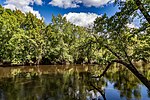Anoka station
2009 establishments in MinnesotaAnoka, MinnesotaNorthstar Line stationsRailway stations in Anoka County, MinnesotaRailway stations in the United States opened in 2009

Anoka station is a commuter rail station in Anoka, Minnesota, located at 2718 4th Avenue. It is served by the Northstar Commuter Rail line. The station features bicycle lockers and two park and ride lots. The north lot has 181 spaces and the south lot has 196 spaces, with a total capacity of 377 vehicles. The commute time to downtown Minneapolis from this station is about 32 minutes. In 2012, the weekday fare to downtown Minneapolis from this station was $3.00. The fare to and from any other station also was $3.00 on weekdays. In 2022, the weekday fares still were $3.00 to downtown Minneapolis and $3.00 to any other station.
Excerpt from the Wikipedia article Anoka station (License: CC BY-SA 3.0, Authors, Images).Anoka station
4th Avenue,
Geographical coordinates (GPS) Address Nearby Places Show on map
Geographical coordinates (GPS)
| Latitude | Longitude |
|---|---|
| N 45.207777777778 ° | E -93.384722222222 ° |
Address
4th Avenue
55303
Minnesota, United States
Open on Google Maps









